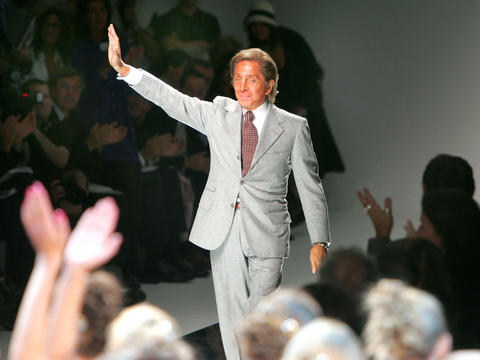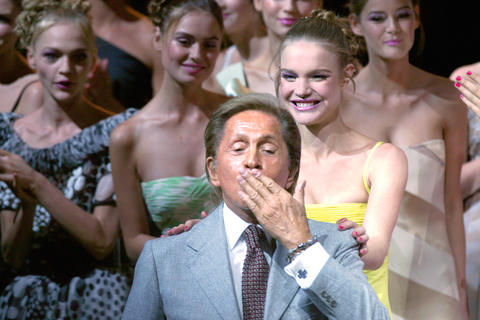Italian designer Valentino, who retired this week after 45 years business, has been called everything from the "Sheik of Chic" to "King of the Red Carpet." A perfectionist with an unparalleled sense of fit and fabric, he has dressed royalty, first ladies and movie stars in his signature scarlet dresses and tasteful couture. The designer unveiled his Swan Song collection in Paris yesterday.
Screen legend Sophia Loren summed up Valentino's appeal: "Femininity and glamour and beautiful things!" She has mixed feelings about his retirement.
"I think it's up to him to decide what he wants to do in his own life," she said. "What I feel about it? I'm a little bit sad, because he is one of the greatest." Born Valentino Garavani in 1932 in Voghera, Italy, he spent much of his teenage years in the local cinema admiring leading ladies like Rita Hayworth and Lana Turner.

PHOTO: AP
"I was crazy about film stars," Valentino said in an interview last year.
"All my life I was fascinated to see a beautiful woman coming down the staircase in a long gown. This was my dream since I was a child and it is for this reason that I am a designer," he said.
At 17, the designer convinced his parents to let him move to Paris, where he studied at the Fine Arts School and at the Chambre Syndicale de la Couture Parisienne, French fashion's governing body.

PHOTOS AFP
During apprenticeships at Jean Desses and Guy Laroche, Valentino demonstrated his skill for sketching and met influential style icons like the countess Jacqueline de Ribes.
By 1959, he was ready to set up shop on his own in Rome, opening a salon on the prestigious via Condotti with backing from his father.
The year after, he ran into Giancarlo Giammetti, the man who would help him build an empire. The two were a couple for 12 years and remain inseparable, in a relationship that is often compared to that of Yves Saint Laurent and Pierre Berge.
Valentino had his big breakthrough in Florence in 1962. His show was a hit and soon he was dressing clients like Elizabeth Taylor and Jackie Kennedy, who commissioned him to design a mourning wardrobe after the assassination of former US president John F. Kennedy in 1963.
Giammetti's business acumen has allowed Valentino to weather successive changes of ownership without ever losing creative control, while becoming wealthy enough to share the lifestyle of his jet-set patrons.
Last year, British-based private equity firm Permira bought the Valentino Fashion Group - which also includes the Hugo Boss and Marlboro Classics labels - for US$3.8 billion. It has appointed Alessandra Facchinetti, formerly of Gucci, to continue designing the women's line.
The 1970s seemed tailor-made for Valentino. Fashion was free and flirty, and life was fun as he partied at the legendary Studio 54 nightclub in New York and hung out with Andy Warhol.
Valentino was not fond of the 1980s, with its bouffant hairstyles and big shoulder pads, and even less of the grunge trend that followed. But throughout, he managed to win over new fans by staying true to his mantra: Keep a woman looking her best.
It helped that unlike Saint Laurent, Valentino was never tempted by substance abuse. A workaholic who often sketches late into the evening, he has always maintained an iron grip on his health and image.
Perma-tanned and impeccably coiffed, the designer owns lavish homes including a chateau near Paris, a 46m yacht and an art collection with works by Picasso, Miro and Basquiat.
After a cameo in the 2006 movie The Devil Wears Prada, Valentino is scheduled to hit the big screen again this year in Valentino: The Last Emperor, a documentary directed by Vanity Fair special correspondent Matt Tyrnauer.

That US assistance was a model for Taiwan’s spectacular development success was early recognized by policymakers and analysts. In a report to the US Congress for the fiscal year 1962, former President John F. Kennedy noted Taiwan’s “rapid economic growth,” was “producing a substantial net gain in living.” Kennedy had a stake in Taiwan’s achievements and the US’ official development assistance (ODA) in general: In September 1961, his entreaty to make the 1960s a “decade of development,” and an accompanying proposal for dedicated legislation to this end, had been formalized by congressional passage of the Foreign Assistance Act. Two

Despite the intense sunshine, we were hardly breaking a sweat as we cruised along the flat, dedicated bike lane, well protected from the heat by a canopy of trees. The electric assist on the bikes likely made a difference, too. Far removed from the bustle and noise of the Taichung traffic, we admired the serene rural scenery, making our way over rivers, alongside rice paddies and through pear orchards. Our route for the day covered two bike paths that connect in Fengyuan District (豐原) and are best done together. The Hou-Feng Bike Path (后豐鐵馬道) runs southward from Houli District (后里) while the

March 31 to April 6 On May 13, 1950, National Taiwan University Hospital otolaryngologist Su You-peng (蘇友鵬) was summoned to the director’s office. He thought someone had complained about him practicing the violin at night, but when he entered the room, he knew something was terribly wrong. He saw several burly men who appeared to be government secret agents, and three other resident doctors: internist Hsu Chiang (許強), dermatologist Hu Pao-chen (胡寶珍) and ophthalmologist Hu Hsin-lin (胡鑫麟). They were handcuffed, herded onto two jeeps and taken to the Secrecy Bureau (保密局) for questioning. Su was still in his doctor’s robes at

Mirror mirror on the wall, what’s the fairest Disney live-action remake of them all? Wait, mirror. Hold on a second. Maybe choosing from the likes of Alice in Wonderland (2010), Mulan (2020) and The Lion King (2019) isn’t such a good idea. Mirror, on second thought, what’s on Netflix? Even the most devoted fans would have to acknowledge that these have not been the most illustrious illustrations of Disney magic. At their best (Pete’s Dragon? Cinderella?) they breathe life into old classics that could use a little updating. At their worst, well, blue Will Smith. Given the rapacious rate of remakes in modern